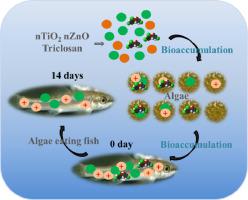Aquatic Toxicology ( IF 4.1 ) Pub Date : 2021-04-03 , DOI: 10.1016/j.aquatox.2021.105824 Xiaying Xin , Guohe Huang , Baiyu Zhang , Yang Zhou

|
Little is known about the trophic transfer of nanoparticles and personal care products via dietary exposure in an algae-algae eating fish food chain. The bioaccumulation of nano-TiO2 (P25 – nTiO2), nano-ZnO (nZnO), and triclosan (TCS) in eight different combinations were explored in this study through algae, Asterococcus superbus, to fish, Gyrinocheilus aymonieri. Results found the bioaccumulation of TCS changed with algal biomass, while the bioaccumulation of Ti and Zn varied with the amount of lipids and proteins in algal cells. In algae, Ti was in the form of nTiO2 and Zn in the form of zinc ion. Due to dietary exposure, Ti and Zn quantity in fish was closely related to that in algae. The quantity of Ti and Zn in algae and fish exposed to the interaction of nTiO2 * nZnO* TCS was higher than that in other treatments. The uptake of Ti and Zn in algae exposed to the interaction of nTiO2 * nZnO had been inhibited, and the corresponding fish also had less Ti and Zn in their tissues. nTiO2-containing treatments had higher Ti proportion in muscle than gill in fish. Treatment nZnO had the most Zn in gill, whereas nZnO * TCS-containing treatments had higher Zn proportion in gut than other tissues. No observation of TCS in fish in all treatments suggested the removal and metabolism of TCS might be induced by tissue recovery and acclimation. This is the first report on trophic transfer of mixed nanoparticles and personal care product in an algae-algae eating fish two-stage food chain.
中文翻译:

食用藻类鱼类食物链中nTiO 2,nZnO和三氯生的营养转移势
对于通过藻类食用鱼类的食物链中的食物暴露,纳米粒子和个人护理产品的营养转移知之甚少。纳米TiO 2的生物蓄积性2(P25 - NTIO 2),纳米氧化锌(nZnO),和三氯生(TCS)在八个不同的组合在本研究中通过藻类,进行了探索Asterococcus超级巴士,以鱼,双孔鱼。结果发现,藻类生物量会导致TCS的生物积累发生变化,而藻类细胞中脂质和蛋白质的含量会导致钛和锌的生物积累发生变化。在藻类中,Ti以nTiO 2的形式存在锌以锌离子的形式存在。由于饮食的关系,鱼类中的钛和锌含量与藻类中的含量密切相关。暴露于nTiO 2 * nZnO * TCS相互作用的藻类和鱼类中的Ti和Zn含量高于其他处理方法。暴露于nTiO 2 * nZnO相互作用的藻类对Ti和Zn的吸收受到抑制,相应的鱼类组织中的Ti和Zn含量也较少。纳米二氧化钛含鱼的肌肉中的钛比例高于鱼中的g。处理nZnO在g中的锌含量最高,而含nZnO * TCS的处理在肠道中的锌比例高于其他组织。在所有处理中均未观察到鱼类中TCS的存在,这表明TCS的去除和代谢可能是由组织恢复和适应引起的。这是关于藻类-食用藻类鱼的两阶段食物链中混合纳米颗粒和个人护理产品营养转移的第一份报告。











































 京公网安备 11010802027423号
京公网安备 11010802027423号